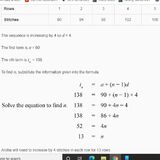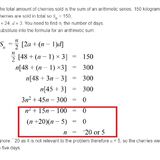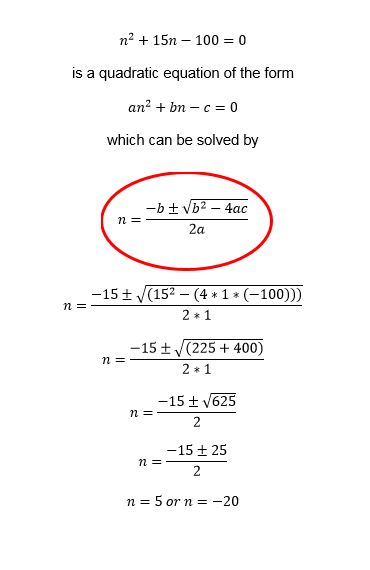Discussion
I've just started a correspondence maths course and I'm stuck on how this example works. You're all cleverer than me so how does this work?

Its to do with Arithmetic Sequences and I can work out what the number for a sequence will be using the formula tn = a+(n-1)d to work out say the 9th term would be this value. I'm just stumped on how to work it out from being given the value to work out the sequence number.

Its to do with Arithmetic Sequences and I can work out what the number for a sequence will be using the formula tn = a+(n-1)d to work out say the 9th term would be this value. I'm just stumped on how to work it out from being given the value to work out the sequence number.
So, they should have left a space between the first 2 lines and the last 4?
Now, you'll have to excuse my terminology and understanding here. But the first row (138 = 90+4n-4), I'm largely ignoring 4n in the first instance as its just doing 90-4 = 86 which I'm then subtracting from my original number of 138 to give 52.
The 4n is then the term number divided by 4, which is then our sequence number of 13
Now, you'll have to excuse my terminology and understanding here. But the first row (138 = 90+4n-4), I'm largely ignoring 4n in the first instance as its just doing 90-4 = 86 which I'm then subtracting from my original number of 138 to give 52.
The 4n is then the term number divided by 4, which is then our sequence number of 13
One more quick one,
On the 86 + 4n part, is there a rule to say whether its 4 multiplied/divided by n?
One thing we all say is 'I'll never need algebra', but it's all around you. My whole work uses CNCs the run off it. I use the pythagoras therum to work out how measurements to see if things are square.
On the 86 + 4n part, is there a rule to say whether its 4 multiplied/divided by n?
StuntmanMike said:
Christ! Are you lot speaking Klingon?

Pretty much, I left school nearly 30 years with a D grade in maths, so it's pretty hard. I'm foolishly doing a physics course too lol. 
One thing we all say is 'I'll never need algebra', but it's all around you. My whole work uses CNCs the run off it. I use the pythagoras therum to work out how measurements to see if things are square.
I'm so glad I dont need to program the machines I use 
Right, this has me stumped. I cant seem to get the the answer to work out correctly.
Josh has started jogging to keep fit. On the first day he jogs 3 kilometres. Each day he adds 0.5 kilometres to the length of his jog. Josh plans to keep increasing the distance he jogs until he gets to jog 8 kilometres.
How many days will it take for Josh to complete one jog of 8 kilometres?
So I've been using the formula for an Arithmetic Series :
Sn = n/2 [2a + (n-1)d]
As well as the tn = a+(n-1)d formula.
If I write it down, the bow legged muppet will take 11 days to reach 8km.
If I use the tn formula it comes out as 6.5 days to reach 8km.

Right, this has me stumped. I cant seem to get the the answer to work out correctly.
Josh has started jogging to keep fit. On the first day he jogs 3 kilometres. Each day he adds 0.5 kilometres to the length of his jog. Josh plans to keep increasing the distance he jogs until he gets to jog 8 kilometres.
How many days will it take for Josh to complete one jog of 8 kilometres?
So I've been using the formula for an Arithmetic Series :
Sn = n/2 [2a + (n-1)d]
As well as the tn = a+(n-1)d formula.
If I write it down, the bow legged muppet will take 11 days to reach 8km.
If I use the tn formula it comes out as 6.5 days to reach 8km.
Edited by Tony Starks on Sunday 7th February 04:11
Edited by Tony Starks on Sunday 7th February 20:47
Gary C said:
so where N = number of days
3+[b](0.5 *[b/] (N-1)) = 8 (3 days to start plus number of days multiplied by half a km but day 1 adds nothing so N-1)
3+(0.5*N - 0.5) = 8 (open up inner bracket)
0.5*N - 0.5 = 5 (take 3 from both sides)
0.5 * N = 5.5 (add 0.5 to both sides)
N = 11 (divide both sides by 0.5)
Think this works (im crap at arithmetic despite having a degree in engineering )
)
you seem to have multiplied here, when the equation is Add? unless theres something I'm missing3+[b](0.5 *[b/] (N-1)) = 8 (3 days to start plus number of days multiplied by half a km but day 1 adds nothing so N-1)
3+(0.5*N - 0.5) = 8 (open up inner bracket)
0.5*N - 0.5 = 5 (take 3 from both sides)
0.5 * N = 5.5 (add 0.5 to both sides)
N = 11 (divide both sides by 0.5)
Think this works (im crap at arithmetic despite having a degree in engineering
 )
)Edited by Gary C on Sunday 7th February 04:28
Halmyre said:
jet_noise said:
Halmyre said:
Even when you get sqrt.(-1)! But that's for the next lesson I think 
As may be the equation itself.
Tony may "have" to use the factorising method as an aid to understanding the nuts & bolts of how quadratics work before being allowed the formula method.
Just to confuse you even more, this I think is the NZ version of GCSE or A level , this is all NCEA level 2 and rather than obtaining an A, B or C etc. It's done on credits. I think for this it's worth 4 credits and to get an A+ I need 80 credits.
Working out how they do things over here is worse than quadratic equations
Gassing Station | Science! | Top of Page | What's New | My Stuff





